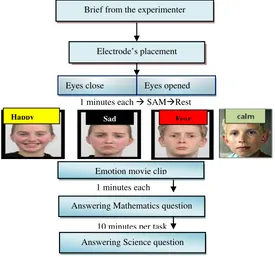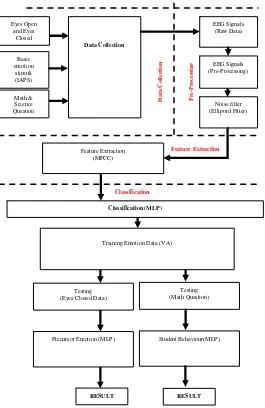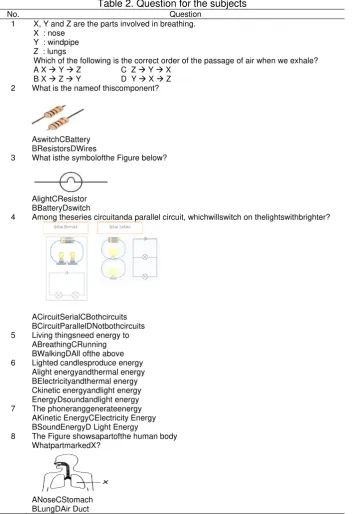DOI: 10.12928/TELKOMNIKA.v13i4.2737 1162
Correlation of Student’s Precursor Emotion towards
Learning Science Interest using EEG
Norzaliza Md Nor1,2, Abdul Wahab Bar1, Sheikh Hussain Shaikh Salleh3 1
Department of Computer Science, Kulliyyah of Information & Communication Technology (IIUM), 53100, Kuala Lumpur, Malaysia
2
Faculty of Bioscience & Medical Engineering, Universiti Teknologi Malaysia (UTM), 81310 Johor Bahru, Johor, Malaysia
3
Center for Biomedical Engineering, Universiti Teknologi Malaysia (UTM), 81310 Johor Bahru, Johor, Malaysia
e-mail: [email protected], [email protected], [email protected]
Abstract
Mathematics and science are two important subjects for students to do well in school. Unfortunately majority of the students are having difficulties in coping with these subjects. Malaysia is ranked third lowest in the Program for International Student Assessment (PISA) for mathematics and science. An emotionally disturbed student seems to have problem coping with the learning of mathematics and science thus it is important to identify the demotivating factors affecting the performance of such students. In this paper, itanalyze the correlation of precursor emotion towards student interest in learning mathematics and science using electroencephalogram (EEG) device. This correlation and their respective emotion can be analyzed based on the 2-D Affective Space Model (ASM) using four basic emotions of happiness, calmness, fear and sadness as reference stimuli. EEG device was used to extract brain waves signal while answering the mathematics and science questions. The EEG signals were captured on the scalp of the student and features extracted using Mel Frequency Cepstral Coefficient (MFCC). Neural network classifier of Multilayer Perceptron (MLP) was used to classify the valence and arousal axes for the ASM.Preliminary results show the relationship of precursor emotion and the dynamic emotions of the student while taking the mathematics and science test. We hope that these results can help us further relate the behavior and interest of students towards the learning of mathematics and science.
Keywords: precursor emotion, student, MFCC, neural network, MLP
Copyright © 2015 Universitas Ahmad Dahlan. All rights reserved.
1. Introduction
Although number of studies had analyzed the developmental trend towards student’s ability-related beliefs in mathematics but few had focused on student’s interest toward learning in mathematics. Ko¨ller et al. [5] did a longitudinal study by analyzing student’s interest towards mathematics in a German high-ability track schools (Gymnasium) at three time points (end of grade 7, end of grade 10, and middle of grade 12). Student interest in mathematics was found to be crucial in education field as a foundation to other future courses. Most of the students were having difficulties in learning mathematics. Answering mathematics questions is a risky decision making process and puts the student under stress. Each answer made by the student will affect his or her results in the mathematics test and their precursor emotion seems plays a critical role. If such precursor emotion continues during the learning experience in class this may affect the students learning experience thus resulting in poor performance.
Although the change in student’s interest in learning may not depend solely on the student’s current emotional state but also it also affected on the environment and the student’s prior emotion. According to Clark [1], emotions are central to human motivation, which include the precursor emotion. In fact precursor emotion was also known to affect student behaviour [7]. Thus student precursor emotion may influence the student’s dynamic emotion and their interest towards learning mathematics.
responses under memory formation of emotional events, however the study on precursor emotion effects by using Electroencephalogram (EEG) is scarce [7]. In this paper, a novel approach has been proposed to analyze and understand the student behavior based on the affective space model (ASM) that enables emotions to be viewed in two different axes of the valence (V) and arousal (A) as the essential basis function as shown in Figure 1.
Figure 1. The Affective Space Model with the Different Position of Basic Emotions with Emotion Primitives Axis x for Valence, and y for Arousal [6]
The valence arousal (VA) approach can also help to analyze and visualize the precursor and dynamic emotions of the student in answering the mathematics questions. It can also reveal the correlations between precursor emotion and the dynamic emotions of the student’s interest. In addition, the study of the student’s dynamic emotions while answering the various mathematics questions can provide a better understanding in analyzing the student interest. Hence the effect on precursor emotion towards early detection of highly emotional agitated student can be identified to detect the student interest towards mathematics.
2. Experimental Setup
To ensure a proper connections and placement of the electrodes on the scalp of the participants, Nuprep electro-gel was used to clean the scalp surface. In order to make the sensors stick well onto the scalp, the Ten 20 TM conductive gel was used. The viscosity paste is needed to ensure that the gel will not flow easily and yet it can be easily remove. Besides, Ten20TM conductive also helped to further reduce the impedance on the sensors.
Data were collected and divided into two parts. Firstly in order to derive the ASM for each individual basic emotion stimuli were used while EEG signals recorded. Secondly while the student was answering each question the EEG signals were also recorded. The experimental design flow and protocol is shown in Figure 2 as a generalize experiments.
Notice from Figure 2 both the eyes open and eyes close will provide initial information about the emotional state of the student. To ensure a proper initialization of the brain activity during eyes open task, student will be looking at a blank white screen. The four basic emotions movie clip will then be displayed for one and half minute per movie clip representing emotion happiness, fear, calmness and sadness. After each movie clip, the student was required to fill up the Self-Assessment Manikin (SAM). Finally student was requested to accomplish two types of tests consisting of mathematics and science questions.
In this paper, student was required to answer 12 questions of mathematics and 10 questions of science. Three levels of questions ranging from easy, medium and difficult were designed. Student was required to answer the easy questions in 10 seconds, medium questions in 20 seconds and difficult questions in 30 seconds for mathematics test. Whereas for science
test, easy questions in 15 seconds, mediums questions in 30 seconds and difficult questions in 40 seconds. All questions were displayed on the personal computer screen and student needs to verbally answer the question.
Figure 2. Experimental setup and protocol
2.1. Stimuli
The emotion’s movie clips were used to obtain emotional responses and one set of mathematics test and science test to identify the student interest. Four basic emotions of happiness, fear, calmness and sadness from the International Affective Picture (IAPS) were used to generate the ASM references of each student. Bernard Bouchard’s synthesized musical clips and Gross and Levenson’s movie clips were used to elicit emotional responses [4] prior to student doing the mathematics and science tests.
2.2. Participants
15 healthy students (8 female and 7 male) were recruited from Sekolah Kebangsaan Taman Universiti 1. Students were chosen from first, second and third grade. These students must be within the age of 10 to 11, since the target subject must be familiar with the primary school’s syllabus taught.
3. Correlation of Student’s Precursor Emotion and Learning Interest
Figure 3 shows the block diagram of the experiments in order toe analyse the correlation of precursor emotion to student’s learning interest. In the pre-processing stage noise and other artefacts will be removed from the raw EEG signals using the ellipord filter. Features will then be extracted using the Mel-frequency Cepstral Coefficient (MFCC) method and finally using the Multilayer perceptron (MLP) to classify the valence and arousal.
Brief from the experimenter
Electrode’s placement
Answering Mathematics question Emotion movie clip
10 minutes per task 1 minutes each
Eyes close Eyes opened
1 minutes each SAMRest
Answering Science question
10 minutes per task
Figure 3. Block Diagram of the experiment
3.1. Feature Extraction (MFCC)
Based on our previous study [7], in this paper features were also extracted using MFCC to extract the low frequency EEG signals. Instead of using 40 MFCC coefficients like most feature extraction for speech, here only 10 MFCC coefficients were extracted and found to be sufficient. Thus every instance will have 160 feature from 16 channels based on 256 nfft points at 83Hz sampling frequency and 20% overlap.
Table 1. Training parameters for MLP No. of hidden layer 1 No. of neuron in the hidden layer 10 Activation function for hidden layer tan-sig Activation function for output layer purelin
Learning rate 0.01
Mean-square error goal 0.1
3.2. Classification (MLP)
MLP was adopted as the classifier in order to classify the extracted features to investigate the precursor emotion and its dynamic. A feed forward artificial neural network
RESULT Precursor Emotion (MLP)
Testing (Eyes Closed Data)
Classification (MLP)
model, multi-layer perceptron maps sets of input data onto a set of appropriate output. Optimal model selection for the number of layer and the number of neuron needed for the best MLP architecture is required to ensure optimum performance.
3.3. Questions for the Test
In this research, we have been requesting the subject to answer 8 science questions for the test.Table 2, depicts the questions that has been prepared for the subject.
Table 2. Question for the subjects
No. Question 1 X, Y and Z are the parts involved in breathing.
X : nose Y : windpipe Z : lungs
Which of the following is the correct order of the passage of air when we exhale? A X Y Z C Z Y X
B X Z Y D Y X Z 2 What is the nameof thiscomponent?
AswitchCBattery BResistorsDWires
3 What isthe symbolofthe Figure below?
AlightCResistor BBatteryDswitch
4 Among theseries circuitanda parallel circuit, whichwillswitch on thelightswithbrighter?
ACircuitSerialCBothcircuits BCircuitParallelDNotbothcircuits 5 Living thingsneed energy to
ABreathingCRunning BWalkingDAll ofthe above 6 Lighted candlesproduce energy
Alight energyandthermal energy BElectricityandthermal energy Ckinetic energyandlight energy EnergyDsoundandlight energy 7 The phoneranggenerateenergy
AKinetic EnergyCElectricity Energy BSoundEnergyD Light Energy
8 The Figure showsapartofthe human body WhatpartmarkedX?
4. Results and Discussion
In this paper only one student data were analysed as a preliminary results. Eyes closed data were first analyzed to identify the precursor emotion. Precursor emotion for student 1 is shown in Figure 4 with combination of calm and sad. Student seems to have both positiveand negative valence and negative arousal while the eyes were closed. This could mean that student was not sure what to feel and the brain is still having low activation.
Figure 4. Precursor emotion of student 1
In Figure 5, it shows that the students seem to be calm emotion at the beginning, having sad emotion in the middle and calm emotion again towards the end. It has positive valence and negative arousal which showing calm emotion. It also has negative valence and negative arousal which showing sad emotion. This indicates that the precursor emotion calm and sad has influence the subject while answering the question.
Figure 5. Student’s dynamic emotions while answering first question
In Figure 6, it depicts negative valence and negative arousal which showing sad emotion. The subject may not have interest in answering the second question due to difficult question. This result also arise in question number seven when the subject also showing sad emotion which has been shown in Figure 7.
Figure 6. Student’s dynamic emotions while answering second question
calm
calm sad
sad
sad
sad sad
calm calm calm calm calm
Figure 7. Student’s dynamic emotions while answering third question
In Figure 8 and Figure 9, the subject is having negative valence and positive arousal which showing fear emotion. This is also revealing that the subject may not have interest in answering the fourth and fifth question.
Figure 8. Student’s dynamic emotions while answering fourth question
Figure 9. Student’s dynamic emotions while answering fifth question
In Figure 10, 11 and 12, the subject is showing negative valence and negative arousal which indicate sad emotion. The subject seems to be showing a negative emotion towards the end of the questions. Perhaps the subject does not understand the question or may not have interest in answering science question.
Figure 10. Student’s dynamic emotions while answering sixth question
sad
fear
fear
Figure 11. Student’s dynamic emotions while answering seventh question
Figure 12. Student’s dynamic emotions while answering eight question
5. Conclusion
In conclusion, the student’s dynamic emotions show a dominant negative emotion towards answering the science test. This could be due to the incapability of the students to answer correctly by which difficult questions seems to indicate negative emotions. Student’s precursor emotion of sad is reflected through out experiments indicating an important role of precursor emotion. Consequently, the precursor emotions have a major influence in human emotion since it has existed in our memory for a long time. Although only one student EEG date was analyzed it shows the potential of correlating precursor emotion to learning interest. Result from our experiment showed that it is possible to identify the student interest towards mathematics according to precursor emotion and student’s dynamic emotions. In future, we are interested to classify the emotion and student behavior by using fuzzy neural network.
Acknowledgement
This work is supported by the Ministry of Education, Malaysia.
References
[1] Clark DE. The Affective Reasoner: A Process Model of Emotions in a Multi-Agent System. Unpublished doctoral thesis, Northwestern University, Chicago.1992.
[2] Mehrabian A & Russell JA. An approach to environmental psychology, Cambridge, MA, USA: MIT Press.1874.
[3] Lang PJ. The three system approach to emotion. In Birbaumer N & Ohman A. The Organization of Emotion (Ed.). Toronto: Hogrefe-Huber, 1993; 18-30.
[4] Chanel G, Kronegg J, Granjean D & Pun T. Emotion assessment: Arousal evaluation using EEG’s and peripheral physiological signals. Proceedings International Workshop on Multimedia Content Representation, Classification and Security, Istanbul, 2006: 530-537.
[5] Ko¨ller O, Baumert J, & Schnabel K. Does interest matter? The relationship between academic interest and achievement in mathematics. Journal for Research in Mathematics Education. 2001; 32: 448–470
[6] Russell JA. A circumplex model of affect. Journal of Personality and Social Psychology. 1980; 39: 1161-1178.
[7] Wahab A, Kamaruddin N, M Nor N, Abut H. “Pre- and Postaccident Emotion Analysis on Driving Behavior”. Smart Mobile In-Vehicle Systems. 2014; 225-239
sad
![Figure 1. The Affective Space Model with the Different Position of Basic Emotions with Emotion Primitives Axis x for Valence, and y for Arousal [6]](https://thumb-ap.123doks.com/thumbv2/123dok/241055.502898/2.595.153.439.166.344/affective-different-position-emotions-emotion-primitives-valence-arousal.webp)





